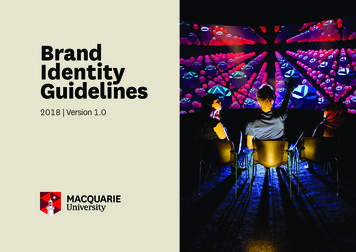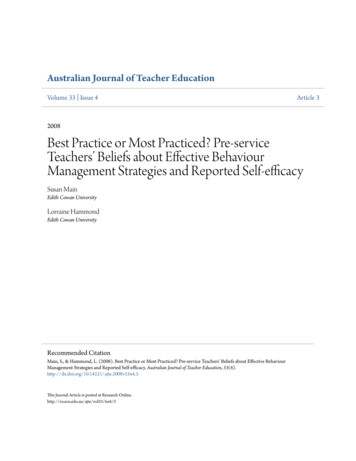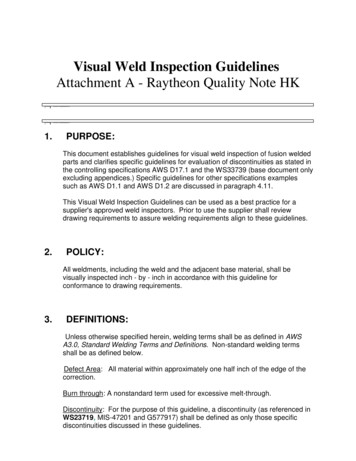
Transcription
2018EAZA Best Practice Guidelines for the whiteEAZA rhinocerosBest Practice Guidelines for thewhite rhinoceros(Ceratotherium Simum)First Edition, July 2018 Lars Versteege1
EAZA Best Practice Guidelines for thewhite rhinoceros(Ceratotherium simum)Editor: Lars VersteegeContact information: Safaripark Beekse Bergen,Beekse Bergen 31, 5081 NJ Hilvarenbeek, The NetherlandsEmail: l.versteege@beeksebergen.nlName of TAG: Rhino TAGTAG Chair: Friederike von Houwald (Zoo Basel, Switzerland)Edition: 1July 20182
EAZA Best Practice Guidelines DisclaimerCopyright (March 2018) by EAZA Executive Office, Amsterdam. All rights reserved. No part of thispublication may be reproduced in hard copy, machine-readable or other forms without advancewritten permission from the European Association of Zoos and Aquaria (EAZA). Members of the EAZAmay copy this information for their own use as needed. The information contained in these EAZABest Practice Guidelines has been obtained from numerous sources believed to be reliable. EAZA andthe EAZA Felid TAG make a diligent effort to provide a complete and accurate representation of thedata in its reports, publications and services. However, EAZA does not guarantee the accuracy,adequacy or completeness of any information. EAZA disclaims all liability for errors or omissions thatmay exist and shall not be liable for any incidental, consequential or other damages (whetherresulting from negligence or otherwise) including, without limitation, exemplary damages or lostprofits arising out of or in connection with the use of this publication. Because the technicalinformation provided in the EAZA Best Practice Guidelines can easily be misread or misinterpretedunless properly analyzed, EAZA strongly recommends that users of this information consult with theeditors in all matters related to data analysis and interpretation.3
PreambleRight from the very beginning it has been the concern of EAZA and the EEPs to encourage andpromote the highest possible standards for husbandry of zoo and aquarium animals. For this reason,quite early on, EAZA developed the “Minimum Standards for the Accommodation and Care ofAnimals in Zoos and Aquaria”. These standards lay down general principles of animal keeping, towhich the members of EAZA feel themselves committed. Above and beyond this, some countrieshave defined regulatory minimum standards for the keeping of individual species regarding the sizeand furnishings of enclosures etc., which, according to the opinion of authors, should definitely befulfilled before allowing such animals to be kept within the area of the jurisdiction of those countries.These minimum standards are intended to determine the borderline of acceptable animal welfare. Itis not permitted to fall short of these standards. How difficult it is to determine the standards,however, can be seen in the fact that minimum standards vary from country to country. Above andbeyond this, specialists of the EEPs and TAGs have undertaken the considerable task of laying downguidelines for keeping individual animal species. Whilst some aspects of husbandry reported in theguidelines will define minimum standards, in general, these guidelines are not to be understood asminimum requirements; they represent best practice. As such the EAZA Best Practice Guidelines forkeeping animals intend rather to describe the desirable design of enclosures and prerequisites foranimal keeping that are, according to the present state of knowledge, considered as being optimalfor each species. They intend above all to indicate how enclosures should be designed and whatconditions should be fulfilled for the optimal care of individual species.CitationThis publication should be cited as follows:EAZA White rhino EEP Best Practice Guidelines; L. Versteege; Safaripark Beekse Bergen; July 2018SummaryThe best practice guidelines, designed as reference manual for any professional working with whiterhino are divided into two sections. Section one describes the natural biology of the white rhinowhereas section two describes the best practice husbandry in captive settings. Chapters includeenclosure design, nutrition, social structure, breeding, handling and veterinary care.4
ContentsEAZA Best Practice Guidelines Disclaimer . 3Preamble . 4Citation . 4Summary . 4List of figures . 8List of tables . 91. Introduction . 10Section 1 - Biology and field data . 111.1 Biology . 111.1.1 Taxonomy . 111.1.2 Morphology . 111.1.3 Physiology . 121.1.4 Longevity . 121.2 Field data . 131.2.1 Geography and Ecology . 131.2.2 Diet and feeding behaviour . 151.2.3 Reproduction . 151.2.4 Behaviour . 16Section 2 - Management in zoos . 172.1 Enclosure . 172.1.1 Dimensions . 172.1.2 Boundary . 172.1.3 Drive-through enclosure . 222.1.4 Substrate . 222.1.5 Furnishings and maintenance . 232.1.6 Environment . 252.2 Feeding . 262.2.1 Basic diet . 262.2.2 Special dietary requirements . 282.2.3 Method of feeding. 292.2.4 Water requirements . 292.3 Social structure . 305
2.3.1 Basic social structure . 302.3.2 Changing group structures . 302.3.3 Sharing enclosure with other species. 322.4 Breeding . 332.4.1 Mating . 332.4.2 Pregnancy . 332.4.3 Contraception . 342.4.4 Birth . 342.4.5 Development and care of young . 352.4.6 Hand-rearing. 362.4.7 Population management . 362.5 Behavioural enrichment . 372.5.1 Rhino behaviour . 372.5.2 Types of enrichment . 382.5.3 Implementation . 402.6 Handling. 412.6.1 Individual identification and sexing . 412.6.2 General handling . 412.6.3 Catching/restraining . 412.6.4 Transport . 422.6.5 Safety . 442.7 Veterinary . 452.7.1 EAZA Bio Bank. 452.7.2 Foot problems . 452.7.3 Skin problems . 462.7.4 Parasites . 462.7.5 Bacterial infections . 472.7.6 Viral diseases . 482.7.7 Reproductive disorders . 482.7.8 Mortality . 492.7.9 Diet . 492.7.10 Anaesthetics . 492.8 Specific problems . 512.9 Recommended research . 516
3. Discussion . 524. References . 534.1 Books . 534.2 Journals. 544.3 Electronic sources. 574.4 Unpublished Works . 584.5 Pictures . 59Appendix I: EAZA standards . 611.Animal care – Welfare, health and hygiene . 622.Animal Care – Veterinary Aspects . 663. Population Management. 683.Safety and Security . 695. Miscellaneous . 72Appendix II: Rhinos and training . 74Appendix III: EAZA Bio Bank Sampling protocol . 797
List of figuresFigure 1. Illustration of the skeleton of a rhino. 12Figure 2. An alarmed rhino looks up . 12Figure 3. Distribution of the two sub species of white rhinoceros, C.s. cottoni and C.s. simum* . 13Figure 4. Examples of primary fencing . 18Figure 5. Abrasion on the second horn . 18Figure 6. Example of a dry moat. 20Figures 7 and 8. Removable calf fence . 21Figure 9. Strong steel door hinges . 21Figure 10. Crush or restraining area . 21Figure 13. Combination of “hard” and “biofloor” stable . 22Figure 11 and12. Complete “biofloor” stable . 22Figure 14. Two white rhinos “bathing” in a Mud wallow . 24Figure 15 and 16. Scratching poles as “barrier” . 24Figure 17. White rhinos grazing in Greater St. Lucia Wetland Park, South Africa . 26Figure 18. Domestic horse (Equus caballus) digestive tract . 26Figure 19. Rhino, ostrich and zebra in mixed exhibit . 32Figure 20. IZW scientist Dr. Robert Hermes confirming pregnancy by carrying out a sonography . 33Figure 21. A southern white rhinoceros gives birth to her calf conceived from AI in Budapest . 35Figure 22. Keeper bottle-feeds white rhino calf. 35Figure 23. A white rhino at Marwell Wildlife Park, UK, is inspecting a blackcurrant ice lolly . 38Figure 24. A white rhino in the Phoenix Zoo investigates the scented bowling balls . 39Figure 25. Rhino walking into crate . 43Figure 26. IATA crate . 43Figure 27. Keepers are inspecting a Southern white rhino . 458
List of tablesTable 1. Measurements of the white rhinoceros . 12Table 2. The typical dental formula for white rhinos . 12Table 3. Physiologic parameter of the white rhino . 12Table 4. Estimated white rhino numbers in wild- / national parks in December 2015 by country . 13Table 5. Reported African rhino poaching mortalities 2006-2015 . 14Table 6. Reproduction facts for the white rhino . 15Table 7. The advantages and disadvantages of commonly used barriers in zoo enclosures . 19Table 8. Possibilities for food items and quantities per adult white rhino per day . 27Table 9. Mineral requirements (in g/kg DM) of free-ranging rhinos compared to domestic horses . 28Table 10. Possible special husbandry adjustments during pregnancy . 34Table 11. White rhino calls . 37Table 12. Stress indicators. 38Table 13. How to minimize stress . 38Table 14. White rhino inoculations with time interval. 45Table 15. Parasites, description and treatment in white rhinos . 46Table 16. Parasites found on white rhinos in captivity . 47Table 17. Diet based health problems. 499
Contents1. IntroductionOne of the main goals of modern zoos worldwide is conservation (WAZA, 2018). According to theIUCN red list 37% of all evaluated species are threatened (17.291 threatened species) (IUCN, 2010a).To keep the white rhinoceros (Ceratotherium simum) from extinction and to maintain a healthy,sustainable captive population, the European Association of Zoos and Aquaria (EAZA) started anEuropean Endangered Species Program (EEP) (Versteege, 2010a; EAZA, 2018). The numbers of whiterhinos are increasing and therefore the white rhino is stated as near threatened since 2002 by theIUCN (IUCN, 2010b). Nowadays 654 white rhinos in captivity are registered on Species 360worldwide, with 286 of them in European zoos. (Species 360, 2018) The first registration of a whiterhino kept in an European zoo was in 1950 (Versteege, 2010a).In this report the best practice guidelines for the white rhino (Ceratotherium simum) are discussed.The best practice guidelines are developed in order to help optimise the conditions for the wellbeingof the animals kept in captivity.The guideline is divided into two sections. The first section provides general information on thespecies biology, conservation status, ecology, diet, reproduction and behaviour. The data is obtainedfrom different literature sources, such as books, articles and the Internet. The second sectioncontains information on the actual management in captivity. This section presents recommendationson the enclosure, diet, social structure, breeding, behavioural enrichment, handling and veterinaryconsiderations. The data to write this section is acquired from different literature sources and fromthe results of a survey that was conducted among EAZA zoos that participate in the EEP program.10
ContentsSection 1 - Biology and field data1.1 BiologyThis chapter covers basic biological information relevant to in situ and ex situ white rhinos. Thetaxonomy, morphology, physiology and longevity are successively discussed.1.1.1 TaxonomyThe taxonomic position of the white rhinoceros (Ceratotherium simum) is described by Burchell(1817), including all living subspecies.Kingdom: Animalia (Animals)Phylum: Chordata (Chordates)Sub phylum: Vertebrata (Vertebrates)Class: Mammalia (Mammals)Order: Perissodactyla (Odd-toed ungulates)Family: Rhinocerotidae (Rhinoceros)Genus: Ceratotherium (White rhinoceros)Species: Ceratotherium simum (White rhinoceros)Sub species: Ceratotherium simum cottoni (Northern white rhinoceros)Ceratotherium simum simum (Southern white rhinoceros)There are many common names for the white rhinoceros, including: White rhinoceros White rhino African white rhinoceros Square-lipped rhinoceros Square-mouth rhinoceros Grass rhinoceros (Kingdon, 1997) Burchell’s rhinoceros (Rookmaaker, 2003)The scientific name for the white rhino is Ceratotherium simum, in which the Greek cerato means‘horn’ and thorium means ‘wild beast’. The Greek simus means ‘flat nosed’ (RRC, 2018).Ten different theories are listed to explain the name ‘white rhinoceros’ for an animal that is grey, notwhite. The popular explanation is that ‘white’ is derived from the African words ‘wyd’, ‘wyt’, ‘weit’ or‘weid’ (all meaning wide), referring to the wide mouth, but this is examined and found to beunsubstantiated and historically incorrect. (Rookmaaker, 2003)1.1.2 MorphologyRhinos are grey and almost hairless (hairs only on ears, tail tips and eyelashes). The head hangs downand only looks up when alarmed (see figure 2). White rhinos have a wide upper lip and a noticeablehump on the back of their neck (see figure 1 and 2). The front and back feet each have three toes andthe front a soft and elastic sole. (RRC, 2018; Fouraker and Wagener, 1996; Tomasova, 2006) Themeasurements of these mega herbivores are shown in table 1 (Foster, 1960; Pedersen, 2009;Tomasova, 2006).11
ContentsFigure 2. An alarmed rhino looks upFigure 1. Illustration of the skeleton of a rhinoTable 1. Measurements of the white rhinocerosMeasurementsWeightHead body lengthTail lengthShoulder heightAnterior hornPosterior hornAdult male1800 - 2500 kgAdult female1600 - 2000 kgNew-borns40 - 60 kg-3.8 - 5 m50 - 70 cm1.5 - 1.8 m94 - 102 cmUp to 55 cmIn table 2 the dental formula of white rhinos is described. “The deciduous premolars 2, 3 and 4 arereplaced by permanent premolars, while premolar 1 is not replaced” (Hillman-Smith et al., 1986).Hillman-Smith et al. (1986) found no signs of incisors or canines in their study.Table 2. The typical dental formula for white 0Premolars4/43/3Molars0/03/31.1.3 PhysiologyInformation on heart rate, respiration rate and rectal temperature is listed in table 3 (Citino andBush, 2007).Table 3. Physiologic parameter of the white rhinoPhysiologic parameterHeart rate (beats/min)Respiratory rate (breaths/min)Rectal temperature ( C)Mean391936.8Min.321636.6Max.422337.2White rhinos have a very powerful olfactory sense (Pedersen, 2009; Tomasova, 2006: Grün, 2006).Hearing is sensitive when not disrupted by other environmental noises (Pedersen, 2009; Tomasova,2006). The eyesight is poor, they can only see motionless forms between 15 to 25 meters away(Owen-Smith, 1973; Tomasova, 2006).1.1.4 LongevityIn the wild a white rhino can reach an age of 40 to 50 years (RRC, 2018). In captivity a white rhino canreach an age of 50 years (Tomasova, 2006).12
Contents1.2 Field dataThis chapter relates specifically to white rhinoceroses in the wild. It includes information ongeography and ecology, diet, reproduction and behaviour.1.2.1 Geography and EcologyDistributionThe Southern white rhino is now the mostnumerous of the rhino taxonomical group. SouthAfrica is the stronghold for this subspecies withsizeable populations in the Kruger national parkand Hluhluwe-Imfolozi. Smaller populations alsooccur in numerous state protected areas andprivate reserves (some of which are also wellprotected). There are smaller reintroducedpopulations within the historical range of thespecies in Namibia, Botswana, Zimbabwe andSwaziland, while a small population survives inMozambique. Populations also have beenintroduced outside of the former range of thespecies i.e. to Kenya, Uganda (meaning that thespecies has been reintroduced to this country) andto Zambia, as can be seen in figure 3 (Emslieand Brooks 1999). The majority (98.8%) of whiterhino occurs in just four countries, namelySouth Africa, Namibia, Zimbabwe and Kenya(Milliken et al., 2009).Figure 3. Distribution of the two sub species ofwhite rhinoceros, C.s. cottoni and C.s. simum** Note: At the request of certain members, the African Rhino Specialist Group (AfRSG) has a policy of not releasing detailedinformation on the whereabouts of all rhino populations for security reasons. For this reason, only whole countries areshaded on the map.HabitatWhite rhinos prefer short-grassed savannah with access to thick bush cover for shade and waterholes for drinking as well as wallowing. The optimal habitat is a combination of grassland and openwoodland. (Tomasova, 2006)PopulationOn December 2015, there were an estimated 20.378 white rhinos living in the wild (see Table 4)(Milliken et al., 2017). In July 2018 there were an estimated 654 living in captivity. (Species 360)Table 4. Estimated white rhino numbers in wild- / national parks in December 2015 by countryBotswanaKenyaMozambiqueNamibiaWhite RhinocerosC.s. cottoniC.s. simum239244129822Trend since 2005upupupup13
ContentsSouth 1033020.3782updownupstableupupBy the end of 2015 the numbers of white rhino in South Africa have decreased from 20.604 at theend of 2012 to 20.378 individuals at the end of 2015. This shows the start of the decrease after arapid increase in continental (Near 2 Threatened) white rhino numbers from 1992 to 2010 (averaging 7.1% growth per year) followed by a levelling off coinciding with escalating poaching. (Milliken etal., 2017).Conservation statusThe Southern white rhinoceros is listed as ‘Near Threatened’ by the IUCN. But the last years the levelof poaching exponentially increased which is jeopardising the survival of this species. (Milliken et al.,2017). The Northern white rhino is listed as ‘Critically Endangered’ as the current population of thesub species is no more than Two individuals, down from an estimated 2.230 individuals in 1960.By 1977, all African rhino species were listed on CITES Appendix I and all international commercialtrade in rhinos and their products became prohibited. However, following a continued increase innumbers, the South African population of Southern white rhino was down-listed in 1994 to CITESAppendix II, but only for trade in live animals to “approved and acceptable destinations” and for the(continued) export of hunting trophies. In 2004, Swazi
To keep the white rhinoceros (Ceratotherium simum) from extinction and to maintain a healthy, sustainable captive population, the European Association of Zoos and Aquaria (EAZA) started an European Endange










